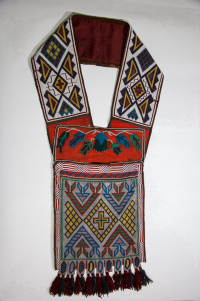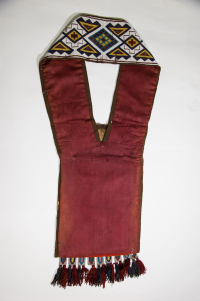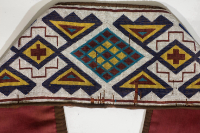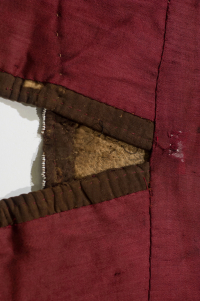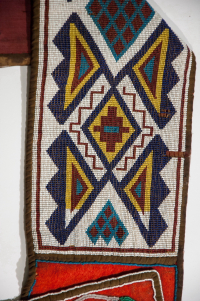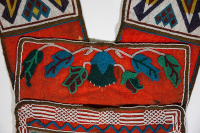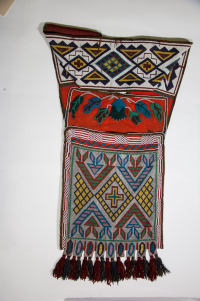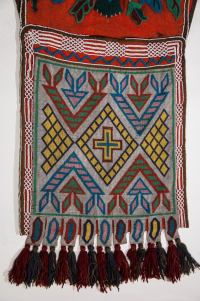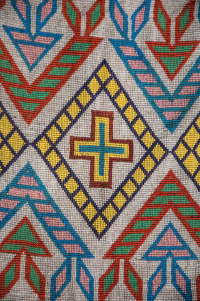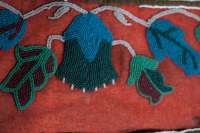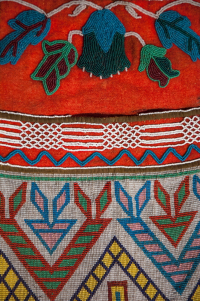Bandolier bag
Bandolier bag
Bandolier bag
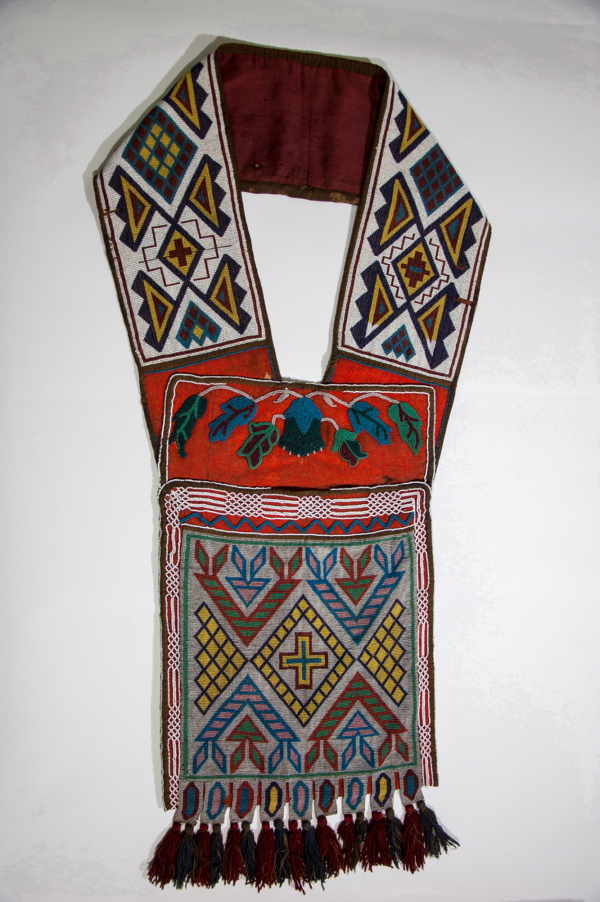
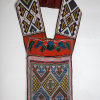
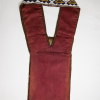
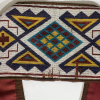
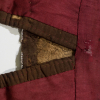
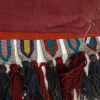
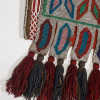


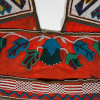
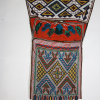
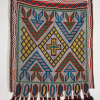
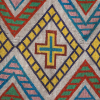
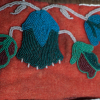
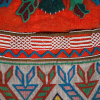
Bandolier, loom woven seed bead panels, straps & pouch on stroud, geometric pattern bi-axially & bilaterally symmetrical, beaded tabs, silk ribbon, wool tassels.
from catalogue records
Read More About This Relative
Cotton thread, canvas, cotton fabric and stroud, seed beads, wool yarn.
Square bag and shoulder straps, Backed by three layers of fabric, outer backing of faded burgundy cotton, inner light brown cotton fabric and heavier red stroud material, onto which the beadwork is sewn, Perimeter of bandolier hemmed by a green-brown fabric, strap hem 1.5 cm, bag hem 0.7 cm wide, stitched down, Continuous loom woven beadwork strap panel, 16.2 cm W stitched to backing cloth, Woven technique uses medium gauge warp strand and double light weft strands, Two weft strands serve different functions; one passes under warp and other passes over top to secure bead, Outside warp strands stitched down with double thread spot stitch 0.5 cm along outside of woven panel, Technique common to both strap and main bag woven panels, Along edges weft threads do half-twist around outside warp strand which is doubled, Lower section of both straps bordered by single line of blue beads, Bag panel (34.5 x 39.5 cm) composed of upper panel (32.7 W x 15.3 cm), and lower beaded pouch (30.5 W x 30.2 cm), Nine loom woven bead tabs (3.2 x 6.5 cm) with yarn fringe, Warp strands from tabs used to tie up lengths of wool, folded over and tied at top creating bell shape, and alternating red and blue tassels.
Colours include yellow, red, blue, green and white, Designs of strap beadwork worked into background of white seed beads within double line, square frame of red seed beads, Strap beadwork features geometric triangular, rectangular, diamond and cross configurations in a white background, Elements bi-axially and bilaterally symmetrical, End sections of straps bordered with single line of medium blue beads on red woollen material, Bag section composed of two parts, upper panel and lower pouch panel, Red stroud fabric used in upper panel, Upper and lower panels trimmed with brown cotton hem and white beading, Upper panel decorated by appliqué beadwork using the overlaid spot stitch floral bead embroidery, Design elements of leaves executed in dark red, blue, dark and light green linked by double line of white stem beads to a central flower of dark and light blue, Lower pouch panel composed of three layers, burgundy cloth, light brown cotton and red stroud fabric, Lower panel framed by two otter track rows of white beads on each side and quadruple otter track rows of white beads on the top on red stroud, Loom woven beadwork of pouch panel, on a background of translucent white beads with an inner frame of green beads and various geometric bead designs, arranged in biaxial symmetry, bar, cross, triangle, diamond figures executed in dark blue, dark red light blue with infill of yellow, pink, and green, Nine beaded tabs attached to bottom edge, lozenge shape design element with light blue, dark blue red and dark red rim and infill of red, blue, yellow and pink, beads on a translucent white background, with alternate red-blue, blue-red paired tassels on each tab.
Worn for festival occasions, may possibly have served at ceremonial functions as well.
loose areas of fabric, missing beads
Provenance
Mr. Edward Dickson, born 1855, Clarence County, Russell, Ontario, moved to Manitoba about 1881. He settled down at Oak Lake, Manitoba, where he built a general store serving CPR workers and local citizens of surrounding areas.
Many Sioux people from the reserve made purchases frequently paid with beadwork, leatherwork and other handicrafts.
During this period, 1885-95, the Dickson’s acquired their collection, probably in the form of gifts and bartered exchange.
catalogue records
Travelling exhibition to Brandon and Portage la Prairie Friendship Centres, Jan-Feb 1975.
About This GRASAC Record
Manitoba Museum













catalogue records show geo-cultural area as Northeast Great Lakes-Riverine
 Knowledge Sharing Platform
Knowledge Sharing Platform

